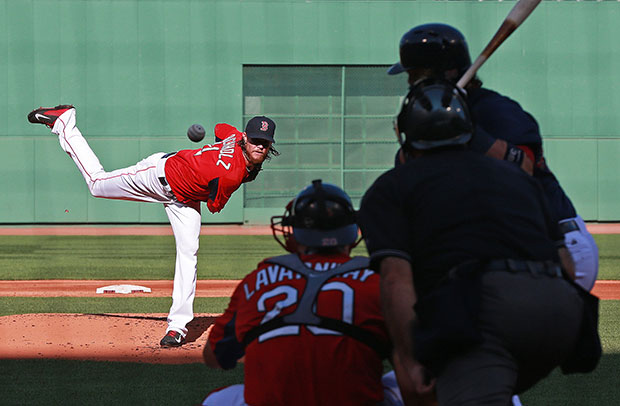 Boston Red Sox pitcher Clay Buchholz had a magnificent first half. In 84.1 innings at hitter-friendly Fenway Park, he had a 1.71 ERA, the lowest figure in the MLB. Opponents managed a mere .535 OPS against Buchholz, which is slightly worse than what Kansas City Royals shortstop Alcides Escobar hits.
Boston Red Sox pitcher Clay Buchholz had a magnificent first half. In 84.1 innings at hitter-friendly Fenway Park, he had a 1.71 ERA, the lowest figure in the MLB. Opponents managed a mere .535 OPS against Buchholz, which is slightly worse than what Kansas City Royals shortstop Alcides Escobar hits.
Buchholz struck out 24.9% of hitters, and walked 8.9%. His very high 84.1% strand rate and very low 3.2% HR/FB ratio seemed like good candidates for regression, and the strikeout rate looked very high for a pitcher that was only generating whiffs at a league-average rate.
Regardless, he still had a 2.47 FIP that only Matt Harvey, Adam Wainwright, and Anibal Sanchez could best.
In his four starts since coming back from the DL, Buchholz has thrown 24 innings with a 1.88 ERA, and the Sox have won three of those starts. Similar to the first half, opposing hitters had a mere .587 OPS against Buchholz.
However, a closer look indicates that Buchholz is not his dominant first-half self. The strikeout rate has dropped to 16.5%. Though Buchholz is walking hitters at a slightly lower rate since his return, he is throwing strikes on 61% of his pitches, down from 65% in the first half.
His fastball, which was sitting at 92-94 before the DL stint, is down to 89-92. With a less dynamic fastball, his changeup has been less effective. Since returning, the whiff rate on his changeup is less than half of what it was before the injury.
Buchholz’ low ERA in September is more a product of getting weak contact on balls in play than a return to his dominant pre-injury form.
While Buchholz seems to have a knack for generating weaker contact than most pitchers, he won’t maintain the .242 BABIP he’s enjoyed in September.
All in all, Buchholz managed just a 3.88 FIP in September, a mark more average than excellent.
When healthy, Buchholz is more of a #2 or #3 than the dominant ace that he was in the first half. Fortunately for the Red Sox, they have a very deep rotation that features resurgent arms John Lackey and Jon Lester, and deadline acquisition Jake Peavy.
The Red Sox don’t need to rely on Buchholz to pitch like an ace. The fact that the pitcher who would have won the ERA crown if he had enough innings to qualify is pitching Game 3 speaks to the depth of their rotation.
